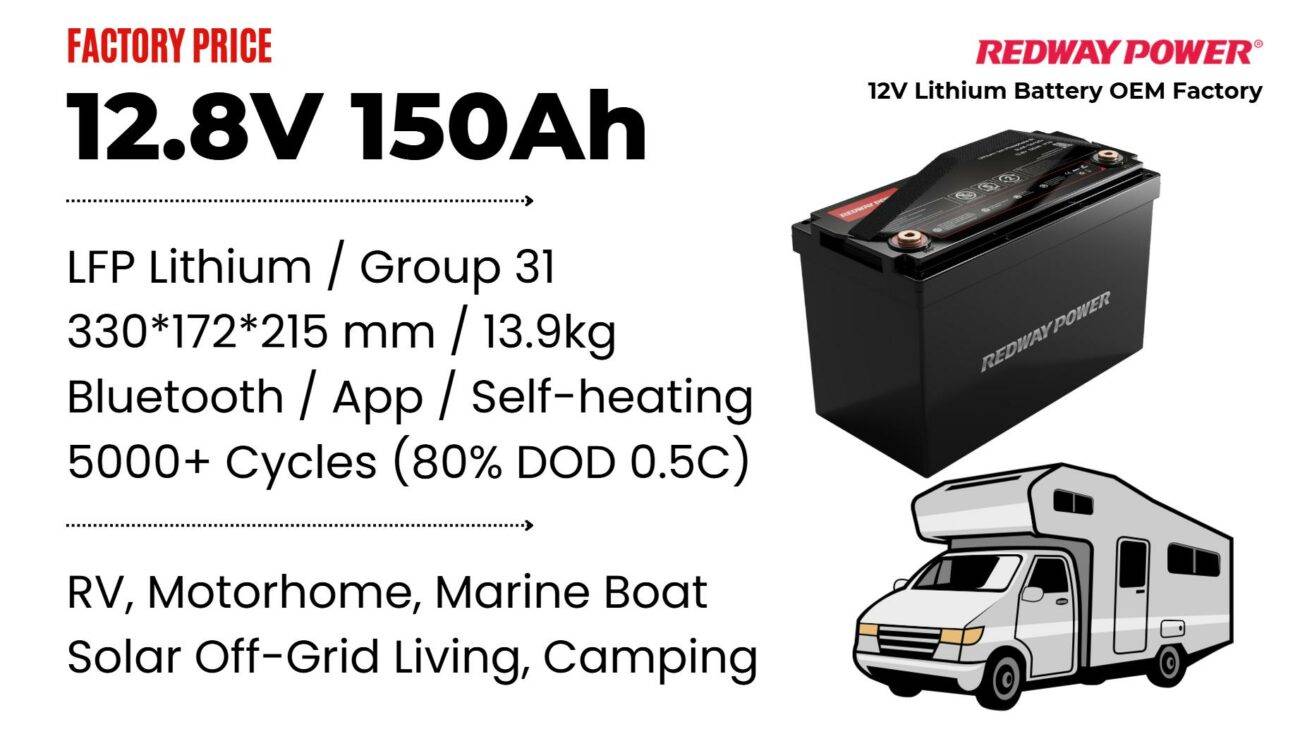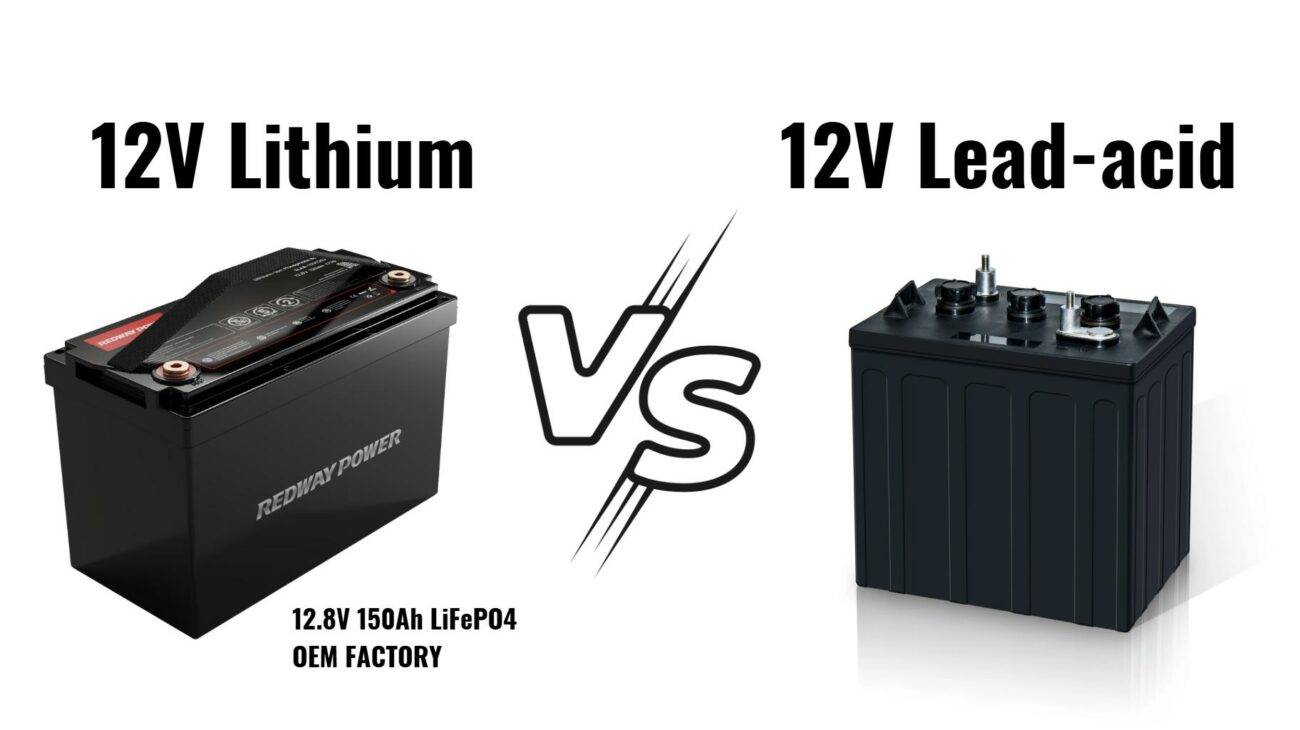- Lithium Golf Cart Battery
- Forklift Lithium Battery
-
48V
- 48V 210Ah
- 48V 300Ah
- 48V 420Ah (949 x 349 x 569 mm)
- 48V 420Ah (950 x 421 x 450 mm)
- 48V 456Ah
- 48V 460Ah (830 x 630 x 590 mm)
- 48V 460Ah (950 x 421 x 450 mm)
- 48V 460Ah (800 x 630 x 600 mm)
- 48V 460Ah (820 x 660 x 470 mm)
- 48V 500Ah
- 48V 560Ah (810 x 630 x 600 mm)
- 48V 560Ah (950 x 592 x 450 mm)
- 48V 600Ah
- 48V 630Ah
-
48V
- 12V Lithium Battery
12V 150Ah Lithium RV Battery
Bluetooth App | BCI Group 31
LiFePO4 Lithium
Discharge Temperature -20°C ~ 65°C
Fast Charger 14.6V 50A
Solar MPPT Charging - 24V Lithium Battery
- 36V Lithium Battery
- 48V Lithium Battery
-
48V LiFePO4 Battery
- 48V 50Ah
- 48V 50Ah (for Golf Carts)
- 48V 60Ah (8D)
- 48V 100Ah (8D)
- 48V 100Ah
- 48V 100Ah (Discharge 100A for Golf Carts)
- 48V 100Ah (Discharge 150A for Golf Carts)
- 48V 100Ah (Discharge 200A for Golf Carts)
- 48V 150Ah (for Golf Carts)
- 48V 160Ah (Discharge 100A for Golf Carts)
- 48V 160Ah (Discharge 160A for Golf Carts)
-
48V LiFePO4 Battery
- 60V Lithium Battery
-
60V LiFePO4 Battery
- 60V 20Ah
- 60V 30Ah
- 60V 50Ah
- 60V 50Ah (Small Size / Side Terminal)
- 60V 100Ah (for Electric Motocycle, Electric Scooter, LSV, AGV)
- 60V 100Ah (for Forklift, AGV, Electric Scooter, Sweeper)
- 60V 150Ah (E-Motocycle / E-Scooter / E-Tricycle / Tour LSV)
- 60V 200Ah (for Forklift, AGV, Electric Scooter, Sweeper)
-
60V LiFePO4 Battery
- 72V~96V Lithium Battery
- Rack-mounted Lithium Battery
- E-Bike Battery
- All-in-One Home-ESS
- Wall-mount Battery ESS
-
Home-ESS Lithium Battery PowerWall
- 24V 100Ah 2.4kWh PW24100-S PowerWall
- 48V 50Ah 2.4kWh PW4850-S PowerWall
- 48V 50Ah 2.56kWh PW5150-S PowerWall
- 48V 100Ah 5.12kWh PW51100-F PowerWall (IP65)
- 48V 100Ah 5.12kWh PW51100-S PowerWall
- 48V 100Ah 5.12kWh PW51100-H PowerWall
- 48V 200Ah 10kWh PW51200-H PowerWall
- 48V 300Ah 15kWh PW51300-H PowerWall
PowerWall 51.2V 100Ah LiFePO4 Lithium Battery
Highly popular in Asia and Eastern Europe.
CE Certification | Home-ESS -
Home-ESS Lithium Battery PowerWall
- Portable Power Stations
What Is the Lifespan of a Typical 12V Lithium Battery in Marine Use?

When it comes to powering boats and marine equipment, the lifespan of a battery is a crucial factor for boaters seeking reliability and efficiency. A typical 12V lithium battery, especially those utilizing LiFePO4 (Lithium Iron Phosphate) technology, offers a significantly longer lifespan compared to traditional battery types. In this article, we explore the expected lifespan of these batteries, their advantages, and factors influencing their longevity.
Lifespan Overview of Lithium Batteries
Average Lifespan
On average, a 12V lithium battery used in marine applications can last between 8 to 10 years. High-quality models may even exceed this duration, with some lasting up to 20 years under optimal conditions. This longevity makes lithium batteries a smart choice for boat owners who want to minimize the frequency of battery replacements.
Charge Cycles
Lithium batteries are designed to endure over 2,000 charge cycles at an 80% depth of discharge (DoD). This performance is notably superior to that of traditional lead-acid batteries, which typically provide only 500 to 1,000 cycles. The ability to withstand more charge cycles not only enhances the overall lifespan but also improves cost-effectiveness over time.
Lifespan Comparison with Other Battery Types
Lead-Acid Batteries
In contrast, traditional lead-acid batteries generally have a lifespan of about 2 to 5 years. Their shorter lifespan can be attributed to limited charge cycles and a higher rate of degradation over time. With only about 500 to 1,000 cycles available, lead-acid batteries are not ideal for long-term marine use, especially for those who frequently use their vessels.
AGM Batteries
Absorbent Glass Mat (AGM) batteries present a middle ground, offering a lifespan of approximately 4 to 7 years. While they outperform standard lead-acid batteries, they still fall short when compared to lithium options. AGM batteries also provide about 1,000 cycles, which is still considerably less than lithium technology.
Factors Influencing Lifespan of Lithium Batteries
Depth of Discharge (DoD)
One of the key factors that influence the lifespan of lithium batteries is the depth of discharge. By regularly discharging lithium batteries to only 80%, users can significantly extend their lifespan. Fully discharging these batteries can lead to faster degradation, so maintaining a lower DoD is beneficial for longevity.
Usage Patterns
The way in which batteries are used also plays a vital role in determining their lifespan. Lithium batteries are less affected by partial discharges, allowing for more flexible usage patterns without compromising their life. Regularly cycling the batteries and adhering to proper charging practices can further enhance their longevity.
Charging Practices
Optimal charging practices can significantly affect the lifespan of lithium batteries. Utilizing a smart charger that adjusts the charging profile according to the battery’s needs ensures better health over time. Maintaining proper voltage levels and avoiding overcharging are essential to maximize battery life.
Conclusion
In summary, a 12V lithium battery used in marine applications provides a remarkable lifespan advantage, often lasting 8 to 10 years or more. This durability makes it an excellent investment for boaters seeking reliability and efficiency. Along with minimal maintenance requirements and higher energy density, lithium batteries are positioned as the preferred choice for marine applications. Their ability to withstand thousands of charge cycles while offering longevity and performance underscores their value in the marine industry.
For those considering battery options for marine use, switching to lithium technology is a decision that will pay off in the long run, ensuring that boaters can enjoy their time on the water without the frequent worry of battery replacements.




















